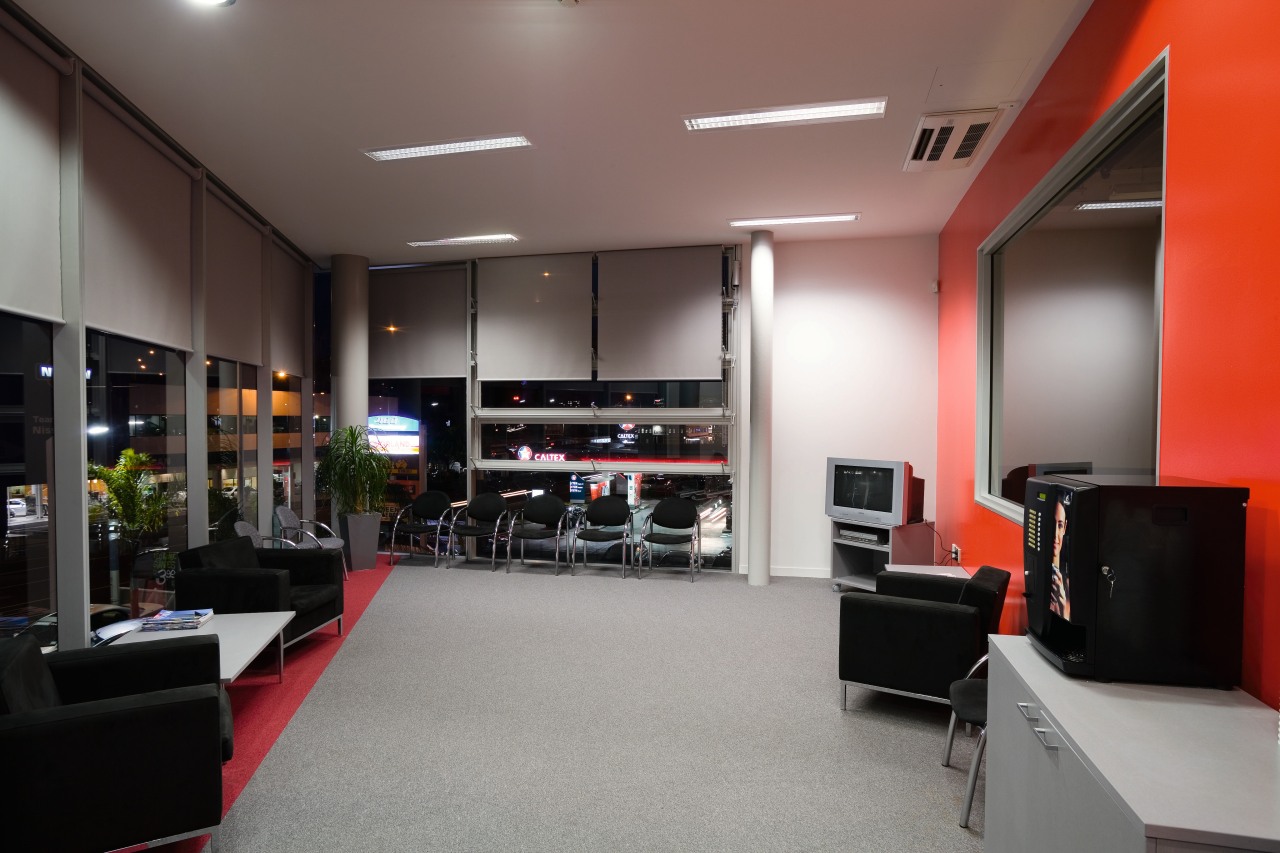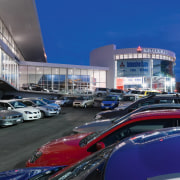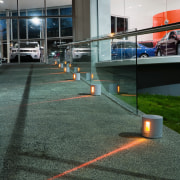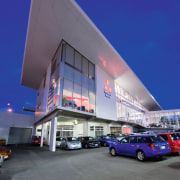Visible difference
With its enviable location and dramatic use of glass, curves and angles, Andrew Simms Mitsubishi Newmarket is a showroom that keeps working even when it's closed
While there are hundreds of motor vehicle showrooms throughout New Zealand, few of them are distinctive enough to be considered landmark structures. With its prime location and complex use of curves and angles, one recent Auckland development might appear to be worthy of this classification.
Previously, the corner of Broadway and St Marks Road in Newmarket, Auckland was the site of an uninspiring, difficult to navigate showroom and service facility. The site is now occupied by Andrew Simms Mitsubishi a dealership housed in a newly-completed, $10 million facility that features several architectural highlights, including an eye-catching glass-sheathed rotunda and large cantilevered overhanging eaves.
Michael O'Sullivan from the Bull/O'Sullivan Architecture team who developed the concept, says the showroom was the result of intensive collaboration with property owner Mitsubishi Motors New Zealand and latterly, Andrew Simms Mitsubishi.
"Two primary goals were to draw pedestrians off Broadway into the showrooms and to stop motorists at the busy Great South Road, Broadway, and St Marks Road intersection, just as Times Square in New York does. The showrooms also had to work for Mitsubishi Motors at all times."
Achieving this meant incorporating effective night architecture. To this end, a glass-walled rotunda fitted with a rotating display turntable was developed. One of few of its kind in New Zealand, the turntable provides constant interior movement. Lit by a feature ceiling lighting system, designed to represent an alloy mag wheel, the rotunda instantly draws the eye of passing commuters.
Supporting this use of light, the dealership is demarcated on both street frontages by lightsticks. As well as meeting council requirements for a clearly defined border, these light the yard and allow evening pedestrians to inspect cars at their leisure.
The dealership is composed of various facets: showrooms, managerial and reception facilities, a customer lounge, boardroom, a prominent rotunda delivery suite and a linking bridge. A continuous ramped path binds the structure's two main sections and extends outside the building to meet the Broadway footpath.
This ramp facilitates foot traffic through the building and enables the display of more than 20 vehicles. The new construction sits atop existing, but extensively renovated, car service facilities.
Mike Sheerin, responsible for Mitsubushi Motor's franchise representation, says the company's new corporate branding was included halfway through construction. The changes include a revised type style, which brings the company into line with its Australian counterpart.
"There were a number of issues we wanted to deal with. We wanted to update the iconic site. We wanted a floorplan to enable the effective display of the maximum number of vehicles. We needed to expand, and make access to the service areas and off-street parking easier," says Sheerin.
"At the outset, the site was to be developed as a Mitsubishi-owned retail outlet, but halfway through the decision was made to change the site operator. Andrew Simms came onboard and recommended a number of layout improvements. Thanks to the flexibility of the design team and contractors we were able to adopt these changes."
Andrew Busler, general manager of Andrew Simms Mitsubishi, says the design was such that only a few modifications were really needed.
"We had some specific layout requirements that were essential in order to enable us to offer the highest level of customer service.
"It was about creating a welcoming environment from the moment the customer drove up the ramp. This included small things: double sliding glass doors at the entrance to reduce the amount of wind entering the building; the placement of the parts division so service team leaders didn't have to travel far from the workshop; and the introduction of a more effective ergonomic layout."
As a result, says Busler, the company has improved its Customer Service Index to one of the highest for dealers of its type.
To allow the company to trade during construction required a coordinated effort from the contractors involved: Aspec Construction, PHC Management and Ecubed Engineering. A good working relationship with the client was essential, says Aspec Construction's Dale de Penning.
"The project was rolled out in two stages the showroom and administration offices followed by the rotunda. During the first stage we knocked the corner off the existing office, taking four offices out of circulation," he says.
Dave Sanders, from project management company PHC Management, agrees that keeping the site operating was the greatest challenge, especially as cars were being repaired and serviced at the time. The company also had to deal with escalating building costs which were the result of New Zealand's recent building boom.
Ecubed Engineering's Mike Brading says the opportunity to push the boundaries on this project, especially with the rotunda and cantilevered roof, was a pleasant change from the norm. With the rotunda, the weight of the glass required pre-loading the steel supports to test the weight.
For more information, contact Andrew Simms Mitsubishi, 500 Broadway Newmarket, phone (09) 523 1939. Bull/O'Sullivan Architecture, phone (09)) 358 3882. Apsec Construction, phone (09) 309 3612. Ecubed Engineering, phone (09) 448 2240. PHC Management, (09) 419 1290.
Story by: Trendsideas
Home kitchen bathroom commercial design
Connected to the ocean
Masculine meets mixed use
Contrast and connection
















